MARKET OVERVIEW
The Global Home Diagnostics and Preventive Healthcare Solutions market constitutes an important niche in the overall healthcare industry. This market deals with products and services intended to facilitate easy remote self-monitoring, diagnosing, and management of various health conditions by individuals in the comfort of their homes. The pressure faced by healthcare systems across the globe in terms of an aging population and the increasing prevalence of chronic diseases will fuel the demand for home-based diagnostic and preventive measures. The market will extend into quite a large variety of devices and technologies, including blood pressure monitors, glucose meters, cholesterol testing kits, wearable health trackers, telemedicine platforms, and much more.
The Global Home Diagnostics and Preventive Healthcare Solutions market covers all the regions and segments of society, targeting a wide range of patients. It involves hardware and software solutions that allow for early detection of health issues, continuous monitoring of health, and personalized management of health. This market will play an important role in reducing the burden on traditional healthcare facilities, and it will enable patients to undergo regular health assessments without a need for frequent visits to clinics by providing tools for this purpose.
A primary characteristic of this market will be its preventive approach. The emphasis will be placed on preventing, rather than treating, a health condition once it has been established. In many cases, services and products will be directed at identifying the risks before they evolve into something much worse. It will benefit health-conscious people, as well as healthcare providers in their efforts to adopt low-cost care methods.
Technological innovations shall propel the emergence of Global Home Diagnostics and Preventive Healthcare Solutions market. Developments within wearable technologies, mobile health apps, and monitoring of remote patients shall emerge toward even more sophisticated and convenient diagnoses. More to that, new innovative discoveries for diagnosis, together with advanced functionalities of wearables and improved portable and portable digital applications and accessories, shall revolutionize patient control of information relating to one's own state, empowering such to take proactive self-decisions over treatment measures. Additionally, integration with telehealth services will further enhance the functionality and appeal of home diagnostics solutions, which will enable easy communication between patients and healthcare professionals.
The regulatory frameworks and standards related to the safety, efficacy, and privacy of home healthcare products will also determine the market. The more people start using these solutions, the stricter the regulatory guidelines will become, protecting consumers and health data integrity. Compliance with these regulations will be key for manufacturers and service providers who wish to stay ahead in the market.
Consumer awareness and education will be crucial for the growth of the Global Home Diagnostics and Preventive Healthcare Solutions market. As people increase in knowledge about preventive healthcare as well as the availability of home diagnostics, demand for this product will be at an all-time high. Marketing efforts and public health campaigns will drive home the importance of regular health monitoring and early detection.
In conclusion, Global Home Diagnostics and Preventive Healthcare Solutions are going to become a vital constituent of the present healthcare system. This market, through its new tools and technology, is likely to bridge the gap of this ever-growing requirement for accessible and efficient, not to mention proactive, health-care solutions. Going forward, significant growth and evolution are in the offing, with advancements in technology and higher consumer awareness in the near future.
Global Home Diagnostics and Preventive Healthcare Solutions market is estimated to reach $71,959.12 Million by 2032; growing at a CAGR of 16.8% from 2025 to 2032.
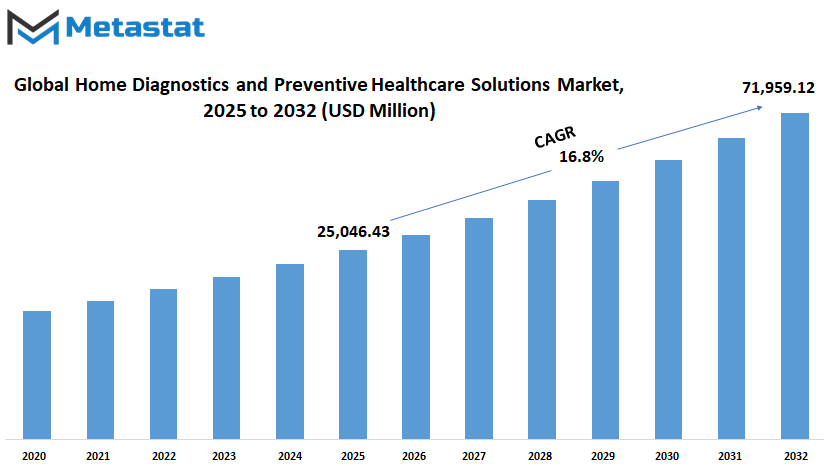
GROWTH FACTORS
The Global Home Diagnostics and Preventive Healthcare Solutions market is at a crossroad, with good growth prospects on the horizon due to several strong factors that epitomize evolving consumer behavior patterns and technological change. One such key growth enabler is a growing consumer recognition of the critical need for detecting diseases early as well as an increasing awareness regarding self-care. An increased number of people today are becoming proactive and trying to do more for their health, especially in terms of monitoring and taking control over their well-being within the comfort of their home. This is because increasingly people have started understanding that earlier intervention will lead to better health outcomes, reduce health care costs, and minimize hospital visitation.
The growth of this market has been somewhat supplemented by the rising use of digital health technologies and telemedicine. The advent of smartphones and wearable devices has enabled people to monitor blood pressure, glucose levels, and heart rate in real-time. Telemedicine has also become a common healthcare option for patients to access healthcare professionals from anywhere. With the integration of technology into daily health practices, home diagnostics has become more accessible and convenient, driving the market forward.
Despite these positive trends, some challenges may slow the growth of the Global Home Diagnostics and Preventive Healthcare Solutions market. The accuracy of some at-home tests is still a major concern. Many devices are reliable, but others may not be as accurate as those conducted in professional medical settings. This lack of regulatory approvals for some tests also creates hesitation among consumers and healthcare providers. Such a regulatory gap can deter the adoption of new diagnostic solutions, especially in markets with strict healthcare standards.
High-cost advanced diagnostic devices are another reason for the market not to gain momentum. While simple monitoring tools might be very affordable, expensive devices with advanced features add a high price tag, so they are out of reach for many. Therefore, cost might be a great barrier for more widespread adoption, especially in low- and middle-income regions where healthcare budgets are more constrained.
However, there are promising opportunities for the Global Home Diagnostics and Preventive Healthcare Solutions market. AI-driven diagnostics and remote monitoring of patients will streamline the management of health services. Artificial intelligence could increase the accuracy of diagnostic tools with personalized health insights and predictive analytics. Combining remote patient monitoring with AI, healthcare services can monitor and treat patients' conditions in a more timely manner and improve their care, ensuring it is effective. It would create new pathways to growth as home diagnostics is included in the healthcare system in the future.
MARKET SEGMENTATION
By Type
The Global Home Diagnostics and Preventive Healthcare Solutions market is going to experience great growth in the coming years. This growth is due to increased technological advancements and a greater need for personal health management. The more people are becoming health-conscious and want easy ways to check their health, the demand for home-based diagnostic tools increases. This change not only affects how individuals look at healthcare but also how the industry develops and distributes these solutions.
Among the key factors is the diversification of available products. The market offers a wide range of options catering to various health needs. Blood Testing Kits and Urine Testing Kits, for example, give people the chance to obtain quick and reliable results from the comfort of their homes. These tools are especially useful for chronic diseases, as users can monitor changes without having to visit healthcare facilities frequently. Genetic Testing Kits are also increasingly in demand, giving users information on potential health risks and helping them make lifestyle and preventive decisions.
Cholesterol Monitoring Kits and Blood Pressure Monitors are a must-have for those at risk of cardiovascular diseases. Regular observation prevents health conditions in the initial stages, followed by timely intervention. Pulse Oximeters also gained popularity during the COVID-19 pandemic because they allow patients to check their oxygen levels at home, a crucial management factor for breathing-related diseases. Testing Kits for COVID-19 will expand this market further, as it is a quick and easy way of identifying the virus, integrated into the preventive healthcare package.
The integration of technology into healthcare solutions is another driving force in this market. Wearable Devices and Telemedicine Platforms have revolutionized how people manage their health. Wearables track various health metrics, from heart rate to sleep patterns, offering continuous insights into an individual’s physical state. Telemedicine Platforms enable remote consultations with healthcare professionals, breaking down geographical barriers and making healthcare more accessible.
Preventive healthcare is also provided by Health Assessment Applications. The varied devices’ data can be analyzed and users are given health advice. Thus, the monitoring, assessment, as well as response to data related to health in real-time enable users to take responsibility for their health proactively.
Looking ahead, the market for Global Home Diagnostics and Preventive Healthcare Solutions will continue growing due to innovations that make health monitoring even more efficient and user-friendly. Advancements in technology mean that people will give more priority to preventive care, and the requirement to push growth will be very high.
By Application
The Global Home Diagnostics and Preventive Healthcare Solutions market is going to grow enormously in the future years, primarily because of technological advancement and an increasing interest in personal health management. As health systems around the world are put under pressure by aging populations and the emergence of chronic diseases, more and more people rely on at-home solutions to monitor and manage their health. This is more about making health matters easy while empowering people to assume control before such issues turn out worse.
The market can be further divided into some key areas based on application that contribute to the expansion of this market. Most important among them is Chronic Disease Management; home-based diagnostic tools are used for people with chronic diseases like diabetes, heart diseases, and hypertension to monitor health regularly. The need for constant hospital visits becomes less, as patients get the comfort and flexibility of staying indoors while still ensuring effective care.
Another important segment is Preventive Health Monitoring. It recognizes health risks at an early stage before they become serious medical conditions. Devices like home blood pressure monitors, glucose meters, and cholesterol testing kits enable an early detection of potential issues. This approach may prevent complications at later stages and reduce healthcare costs in the long run.
Another area that has also grown is Fitness and Wellness Tracking, which has allowed devices to become wearable activity trackers, which can track everything from the amount of exercising done to sleep patterns and heart rate. The tools keep users healthy by providing immediate feedback in order to gradually influence a lifestyle of healthier habits. They started from simple pedometers to more sophisticated health monitors, reflecting the evolution of interest in general wellness.
This rise in Personalized Healthcare also impacts the market. With diagnostic tools customized to address specific health issues, the provider will be able to develop specific treatment plans, leading to a more accurate and efficient treatment plan. This form of personalization will continue to grow with improvements in technology and enhance health.
Yet disease risk assessment is gaining popularity among the population: such tools assess one's probable chances of disease in the face of genetic predisposition, lifestyles, and exposure to environmental toxins. This motivates early intervention, lifestyle alteration, and enlightened choices regarding their health care.
The Global Home Diagnostics and Preventive Healthcare Solutions market will continue to rise with advancing technology and humanity's quest for improving health management as people have higher aspirations in terms of efficiency. The future of healthcare would be better in terms of being more personalized, accessible, and preventive, where the disease-treatment paradigm would be reversed by adopting wellness-related preventive attitudes that emphasize health preservation over disease treatment.
By End-user
Individual consumers are becoming more proactive about their health and are using devices such as wearable fitness trackers, blood pressure monitors, and glucose meters to track their daily health metrics. This group will continue to grow as people seek to take control of their health from the comfort of their homes. The convenience of these tools not only helps in early detection of health issues but also encourages individuals to adopt healthier lifestyles. As technology becomes more affordable and accessible, even those in remote areas will benefit from these innovations.
The other large segment consists of healthcare providers. Hospitals, clinics, and doctors are increasingly recommending the patients to continuously monitor themselves through at-home diagnostic tools. This allows them to have control over their chronic diseases and avoid hospital visits as frequently. Remote patient monitoring is on the rise and will enable healthcare professionals to intervene better in real time. Patients' outcomes will be improved, and the usage of healthcare resources will be optimized.
Corporate wellness programs are another area where the Global Home Diagnostics and Preventive Healthcare Solutions market will see growth. Companies are realizing the importance of employee health and are investing in tools that promote well-being. Giving employees access to health monitoring devices and preventive care resources can reduce absenteeism and increase productivity. The health-conscious nature of workplaces gives reason to believe that this market will continue to grow further, focusing on the adoption of more widespread remote and hybrid work models.
The elderly population is an important part of this market. The aging of the global population presents a growing need for solutions that ensure health and safety while fostering independent living. Home diagnostic equipment especially designed for the elderly can keep track of the older person's vital signs, monitor falls or any other accidents, and remind seniors about their medications. The peace of mind brought to family members and caregivers due to real-time health updates would also be a bonus.
Ahead of this, Global Home Diagnostics and Preventive Healthcare Solutions market would see the effects of advancements in artificial intelligence, telemedicine, and wearable technology. These integrated technologies would result in more customized, efficient, and accessible health care to larger sections of society. The current shift from a cure to a preventive approach toward illnesses would drive the future direction of health care and the resultant impact on the Global Home Diagnostics and Preventive Healthcare Solutions market.
By Sales Channel
The Global Home Diagnostics and Preventive Healthcare Solutions market is poised for rapid growth because technology is revolutionizing how individuals manage their health. More convenient and individualized healthcare choices have been leading the way, thus making it easy for patients to monitor and take care of themselves from home. Increasing health awareness, rising chronic diseases, and the advent of technological advancements are propelling this market forward for the convenience and efficiency of healthcare services.
An important factor behind this market’s growth is the multiple sales channels available for selling these products and services. Direct-to-Consumer (D2C) Platforms are now popular, which enable companies to have a direct relationship with their customers. Companies can then tailor their products and services while bypassing the intermediaries; thus, customers can receive quicker delivery and tailored health solutions. In this model, companies will not only be in control of their customer experience but also get an opportunity to gather valuable data for improvement purposes. Retail pharmacies still hold a considerable market share in the Global Home Diagnostics and Preventive Healthcare Solutions market.
These pharmacies provide consumers easy access to various diagnostic kits and preventive healthcare tools, not only that, but also with professional guidance from pharmacists. This ease and the fact that brands do have associated trust with consumers against them would continue to ensure retail pharmacies play an important role in distributing these products.
Other essential sales channels are e-commerce platforms, which have changed the face of the purchase of health care products by consumers. E-commerce has made online shopping a very convenient platform with product comparisons and reviews available at one click. This will increase as people become more comfortable purchasing health-related products online. Another aspect that is expanding the sales channel is logistics and delivery services, where health-related sensitive products can be delivered safely and effectively.
Diagnostic labs and healthcare centers also contribute to the market, offering professional-grade diagnostic solutions that can be used in conjunction with home-based tools. These institutions often provide more complex tests and services, complementing the simpler home diagnostic kits. The integration of home diagnostics with healthcare centers ensures a more comprehensive approach to preventive healthcare, allowing for timely medical intervention when needed.
Looking forward, the Global Home Diagnostics and Preventive Healthcare Solutions market will keep changing with time, as technology advances and the demand for easy, personalized healthcare grows. This market is on its way to becoming a keystone of modern healthcare, supported by diverse sales channels that facilitate accessibility and innovation.
|
Forecast Period |
2025-2032 |
|
Market Size in 2025 |
$25,046.43 million |
|
Market Size by 2032 |
$71,959.12 Million |
|
Growth Rate from 2024 to 2031 |
16.8% |
|
Base Year |
2024 |
|
Regions Covered |
North America, Europe, Asia-Pacific, South America, Middle East & Africa |
REGIONAL ANALYSIS
The market for Global Home Diagnostics and Preventive Healthcare Solutions is registering tremendous growth mainly supported by technological advancement and awareness of personal health management. Home-based diagnostic tools and preventive solutions are now in high demand, as individual monitoring and health management become necessary to beat the increasing chronic diseases and rapidly growing aging population that threatens the global healthcare system worldwide. This shift is visible in all regions, with each making their own specific contributions to the market's expansion.
In North America, the market is particularly robust due to the presence of advanced healthcare infrastructure and high consumer awareness. The United States leads this region, supported by innovative companies and widespread adoption of health technologies. Consumers are increasingly relying on home diagnostic devices for routine health checks, reducing the need for frequent hospital visits. Canada and Mexico also show promising growth, with rising healthcare investments and government initiatives promoting preventive care.
The second key geography is Europe, which also heavily contributes to the market with contributors like the UK, Germany, France, and Italy. With these nations comes the advantages of a good well-established health-care system along with strict regulations providing assurance to users of home diagnostics in respect to the quality and safety. Moreover, non-invasive diagnostic techniques along with focus on the disease diagnosis in their initial stage also drives this region's market growth. More than any other thing, an ageing population in many of Europe's nations fuels demand for home healthcare.
The Asia-Pacific market is growing fast, driven by rising healthcare awareness and improving economic conditions. Some of the biggest contributors to growth are China, India, Japan, and South Korea, driven by increasing populations of middle-class citizens and an increase in accessibility to healthcare technology. In particular, the high population base of China and India provides a big opportunity for expanding the market. As technology costs come down, more people invest in home diagnostic tools, so the region remains strong in terms of growth.
The regions of South America and the Rest of Latin America are where countries like Brazil and Argentina have been steady progressers in the adoption of home diagnostics and preventive healthcare solutions. Here, increasing healthcare expenditure and awareness about early disease detection contribute to market growth. In these regions, improving healthcare infrastructure through the efforts of the governments helps in wider acceptance of home healthcare devices.
Lastly, the Middle East & Africa region, comprising GCC countries, Egypt, and South Africa, is emerging as a growing market for home diagnostics. Despite some regions where access to health care is not so good, this region continues to grow on the premise of increasing demand by its people for preventive health care solutions, particularly in major cities. Initiatives being adopted by the governments to upgrade health care systems and to increase public awareness are driving the market growth in the coming years.
The global market for home diagnostics and preventive healthcare solutions is likely to involve even greater regional development with local adaptation to the unique healthcare needs of the population being served.
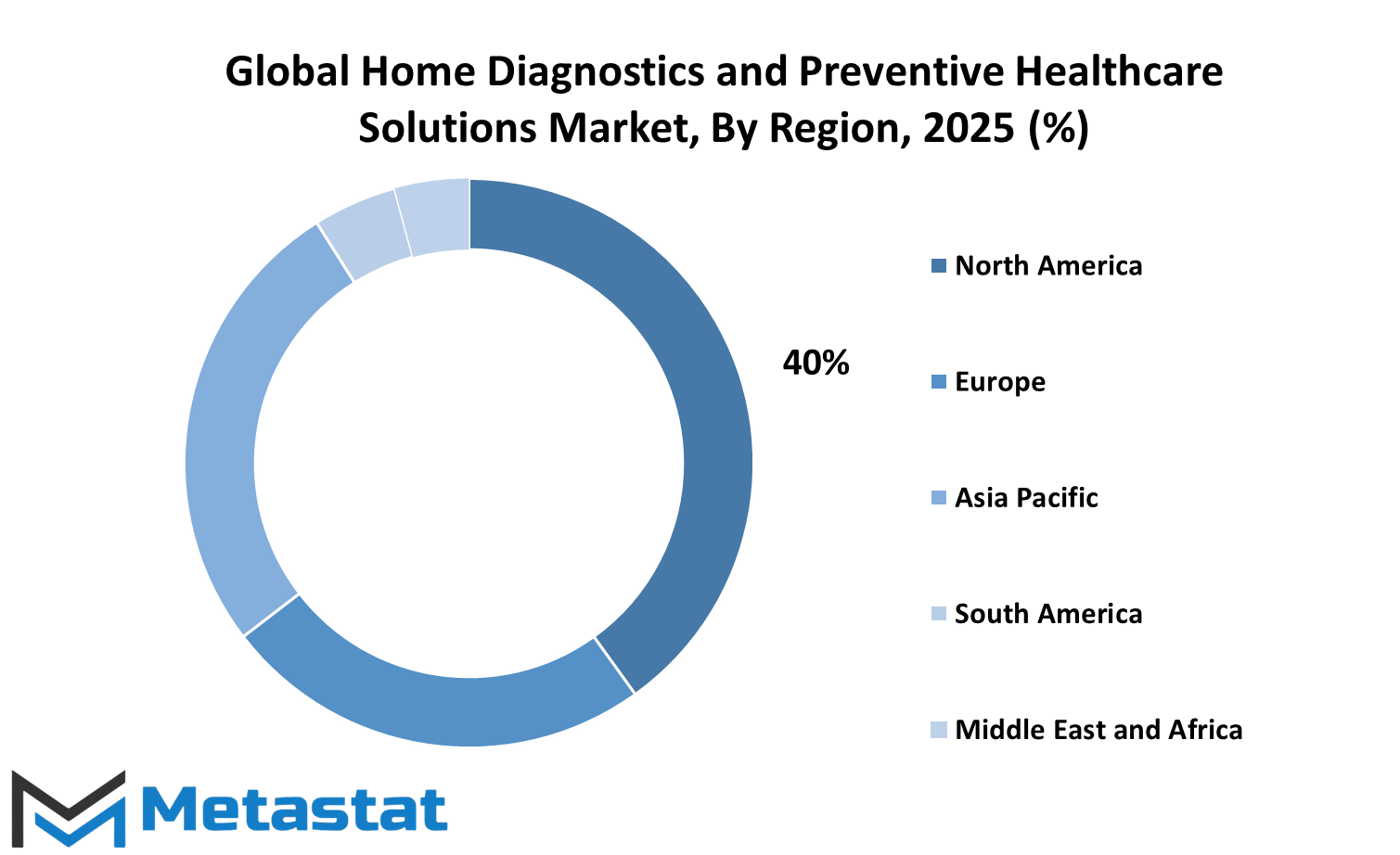
COMPETITIVE PLAYERS
The Global Home Diagnostics and Preventive Healthcare Solutions market is growing rapidly, being led by the emergence of technology coupled with the rising awareness in managing personal health. It provides an arena for more comprehensive development as people try to keep track of their health at a home comfort level that suits their budget and delivers precise results. It is against this background that the demand for home diagnostics, preventive care products, and early detection technologies will increase steadily year in and year out.
Various market leaders are changing this market with distinct inventions and offerings, ranging from smaller makers of the medical device to big ones. Examples of such companies include Thriva Ltd and Everlywell, Inc., which are known for their home blood testing kits that can be easily used in monitoring health indicators such as cholesterol levels, vitamin deficiencies, and hormonal balances. LetsGetChecked also gained attention because of its home testing services, from sexual health checks to general wellness tests. These companies are working on making health data accessible, empowering people to take proactive steps in managing their well-being.
Meanwhile, experienced healthcare giants such as Abbott Laboratories and F. Hoffmann-La Roche Ltd are leveraging their know-how to produce high-end diagnostic equipment for home use. Their equipment is generally more detailed, yielding very accurate outcomes supported by decades of clinical research. Medical device giant Medtronic Plc is venturing into the home healthcare sector through the integration of its products with remote monitoring networks, making it possible for patients to control chronic conditions like diabetes better.
Technology companies are also changing this market. Fitbit, now owned by Google, and Withings are the first companies in wearable technology, which provides users with continuous health data such as heart rate, sleep patterns, and physical activity. These devices help people track their fitness goals but also contribute to early detection of potential health issues. HealthifyMe, with AI-powered health coaching, and Omron Healthcare, famous for its blood pressure monitors, are further revolutionizing the preventive healthcare landscape.
The Global Home Diagnostics and Preventive Healthcare Solutions market will further assimilate into the digital health platform, artificial intelligence, and personalized medicine in the future. In the coming future, these companies will come out with more developed, accurate, and user-friendly devices as a result of improved technology, and preventive healthcare would become a regular affair in one’s life. The competition will only enhance innovations, and at the end, consumers will get better solutions to manage their proactive health.
Home Diagnostics and Preventive Healthcare Solutions Market Key Segments:
By Type
- Blood Testing Kits
- Urine Testing Kits
- Genetic Testing Kits
- Cholesterol Monitoring Kits
- COVID-19 Testing Kits
- Blood Pressure Monitors
- Pulse Oximeters
- Wearable Devices
- Telemedicine Platforms
- Health Assessment Applications
By Application
- Chronic Disease Management
- Preventive Health Monitoring
- Fitness and Wellness Tracking
- Personalized Healthcare
- Disease Risk Assessment
By End-user
- Individual Consumers
- Healthcare Providers
- Corporate Wellness Programs
- Elderly Population
By Sales Channel
- Direct-to-Consumer (D2C) Platforms
- Retail Pharmacies
- E-commerce Platforms
- Diagnostic Labs and Healthcare Centers
Key Global Home Diagnostics and Preventive Healthcare Solutions Industry Players
- Thriva Ltd
- Everlywell, Inc.
- LetsGetChecked
- Abbott Laboratories
- F. Hoffmann-La Roche Ltd
- Medtronic Plc
- Fitbit (Google)
- Withings
- HealthifyMe
- Omron Healthcare
WHAT REPORT PROVIDES
- Full in-depth analysis of the parent Industry
- Important changes in market and its dynamics
- Segmentation details of the market
- Former, on-going, and projected market analysis in terms of volume and value
- Assessment of niche industry developments
- Market share analysis
- Key strategies of major players
- Emerging segments and regional growth potential



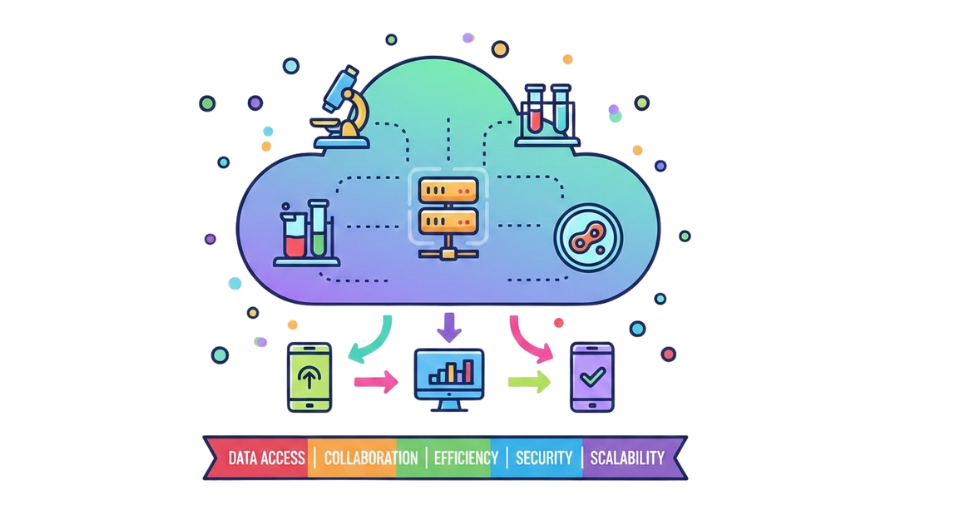
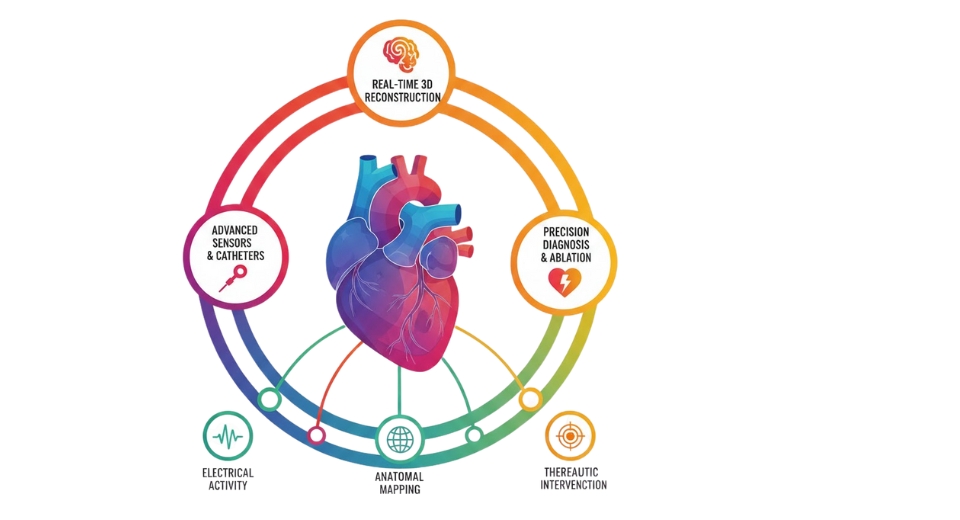
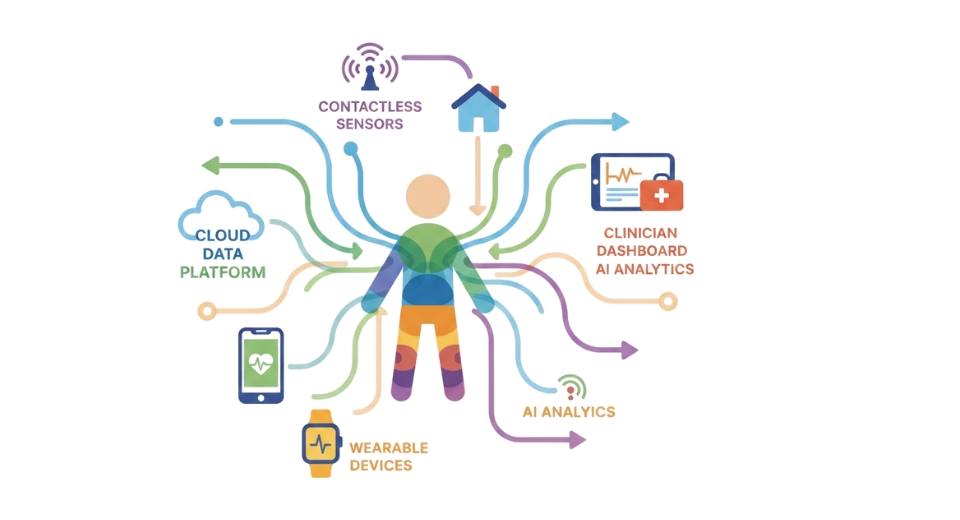
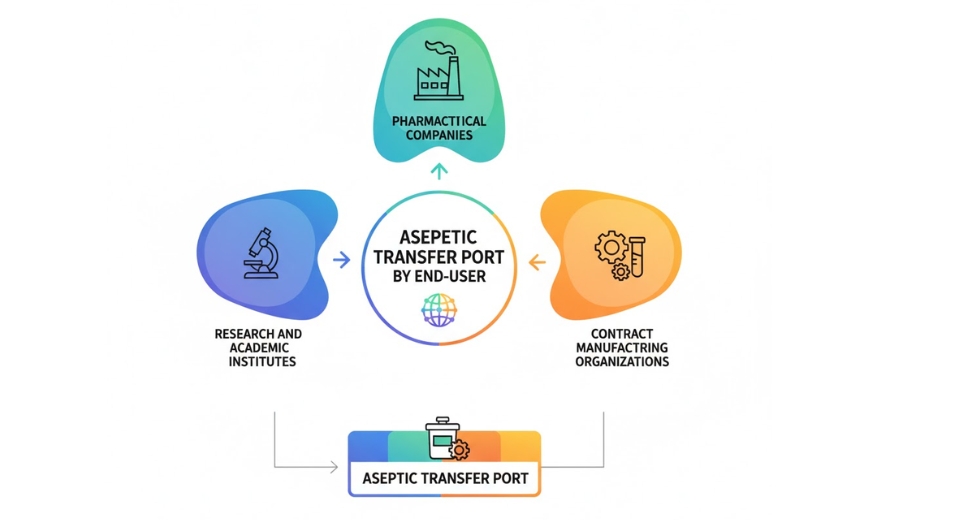

 US: +1 3023308252
US: +1 3023308252






